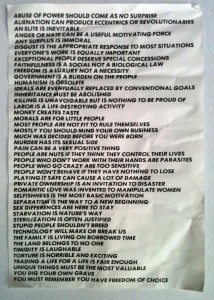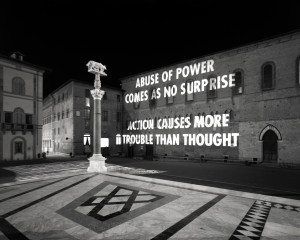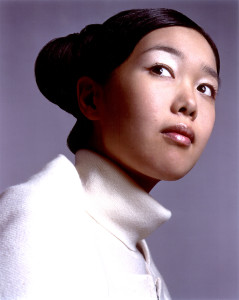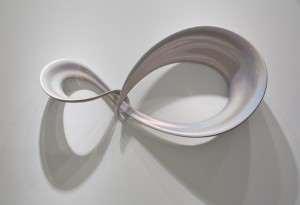https://static-secure.guim.co.uk/sys-images/Arts/Arts_/Pictures/2012/6/4/1338825842295/Jenny-Holzer-008.jpg
I was first introduced to Jenny Holzer my sophomore year of high school in art class. Our assignment was to take inspiration from her concept of “truisms” (which I’ll cover more below), or broad, sweeping, controversial statements meant to make people think. I thought the assignment was really interesting (I wish I had a picture of my pieces to show you guys!) and she was one of the first artists who made me realize that words could have a massive impact on a piece of art. In fact, they could even be an art form all on their own.
Holzer went to several colleges to study art, including the Rhode Island School of Design, where she began exploring what she is so well-known for today. When moving to New York City after college (the obvious choice for any aspiring artist, apparently), she really delved into the idea of using words and installations as her main art form. In 1977, she began working on her Truisms series, which I alluded to earlier. What’s so interesting about this series is that it was truly interactive artwork– Holzer would post papers around the city printed with her truisms in all capital letters. The truisms were often shocking statements meant to inspire discussion like “FREEDOM IS A LUXURY NOT A NECESSITY” or “THE IDEA OF REVOLUTION IS AN ADOLESCENT FANTASY,” but also more reasonable (and kind of really obvious) things like “TORTUE IS BARBARIC.” I think all of us would agree with that last one (at least i hope so, anyway). Apparently, people had a really strong reaction to her efforts. Oftentimes, a passerby would “scribble messages on the posters and make verbal comments” and Holzer would stand around to listen and observe the effects her work had on people.
http://gallery.98bowery.com/truisms-poster/
An example of a truisms poster.
Her blunt, often contradictory statements took not only the art world by storm, but also the general public, which I think is really admirable since she actively tried to make her work so accessible. I like that Holzer sees art as something that everyone should have the privilege to absorb and react to. She really took that concept to the next level in the 1980s, when she began using light emitting machines in order to project her truisms onto public spaces, like in Times Square or the World Trade Center. She didn’t dilute her messages at all, despite the fact that they were so widely publicized. From the 1980s and into the early 1990s, she continued covering heavy, dark subject matter like death and corruption.
http://projects.jennyholzer.com/uploads/project/image/attachment/407/7N11_113_09.jpg
One of Holzer’s projections. I’ve noticed that most of the photographs of these installations are in black and white, which makes the text seem so powerful to me. It’d be interesting to see what kind of vibe these projections give off in real life.
Interestingly, Holzer has been compared to Diane Kruger, a graphic artist who I covered earlier in the semester. They both tackle some pretty intense themes, and use text in their work, so I think that’s where the parallels are drawn. As with Kruger, a lot of Holzer’s truisms have been reprinted on clothing, posters, mugs, etc. Both women have created art that really managed to seep into mainstream life.
I think people are drawn to the rawness and simplicity of Holzer’s work– I know I do, at least. She is unafraid to use controversy as a means to inspire rich discussion and dialogue with uncomfortable topics, which is really, really cool. I encourage you to look up more of Holzer’s work, because it’s so interesting! You can skim through a huge list of her truisms here.
Sources:
http://www.moma.org/collection/works/63755
http://www.artnet.com/artists/jenny-holzer/biography
http://www.arthistoryarchive.com/arthistory/contemporary/Jenny-Holzer.html
http://www.pbs.org/art21/artists/jenny-holzer















